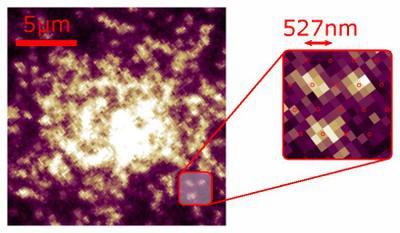When cooled near absolute zero, a dilute gas of atoms behaves according
to the rules of quantum mechanics. Due to the precise control with which
these ultracold gases can be trapped and manipulated, they form an
exemplary system in which to study many-body quantum physics. Using
different species of atoms allows the study of bosonic or fermionic
quantum particles, the interaction strength between particles can be
tuned over a wide range, and many different magnetic and optical
potentials are available. Taking advantage of the range of tunable
parameters, experiments with ultracold gases can be used as quantum
simulators to study the behaviour a particular many-particle
Hamiltonian.
To simulate the physics of electrons in the crystal lattice of a
material, ultracold atoms can be placed in an optical lattice – a
periodic potential generated by the interference of several laser beams.
Experiments with optical lattices have been used to explore the quantum
phase transition of a Bose gas between superfluid and Mott insulating
states, the effect of strong interparticle interactions in graphene, and
the response of particles to extremely strong applied magnetic field.
To precisely read out the results of these kinds of simulations,
experiments using bosonic rubidium atoms have incorporated
high-resolution fluorescence imaging of atoms trapped in the optical
lattice, allowing for a measurement of the density correlations at the
level of single atoms and single lattice sites. Experiments which read
out the results of a lattice quantum simulation with single-site
precision have been termed ‘quantum gas microscopes’.
Recently, our lab has finished construction of a new quantum gas
microscope experiment which extends the capability for single-atom and
single-site resolved imaging to a fermionic species of atom. This
development opens many new avenues for quantum simulation, including an
investigation of the antiferromagnetic states of the Hubbard model which
may be linked to the ‘high-Tc’ superconductivity of cuprate materials.
In this talk I will outline the challenge of achieving single-atom
sensitive fluorescence imaging and outline the details of our experiment
which achieves quantum gas microscopy with fermionic 40K.
-

- Graham_Edge_seminar

